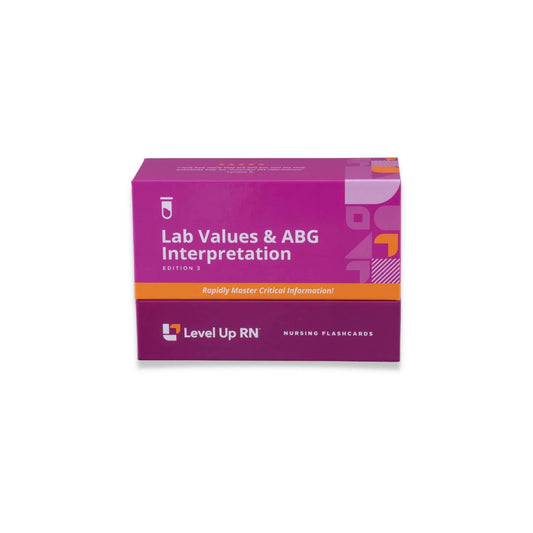In the body, we have several buffers that help regulate the acid-base balance. Acid-base balance is measured by pH, and it's important for the body to keep the pH level within the normal range of 7.35 to 7.45. The body constantly works to achieve this homeostasis. Keeping pH levels within a normal range allows the body to function optimally. Blood that is too acidic or too basic can be dangerous, which is why pH is an important measurement in an Arterial Blood Gas test.
Lab Values & ABG Interpretation - Nursing Flashcards
First line of defense: Chemical buffers
The first line of defense for regulation of the acid-base balance in the body are chemical buffers. These chemical buffers are present in our bodily fluids and act immediately to bind or release hydrogen ions and help promote acid-base balance in the body.
There are several chemical buffers you should be familiar with when it comes to ABGs. These include the carbonic acid-bicarbonate buffer system, the phosphate buffer system, and protein buffers, which include albumin, globulins, and hemoglobin.
For some chemistry background, a buffer is a solution, usually containing an acid and a base, that can resist pH change. These buffers are quite helpful when the body is seeking pH homeostasis!
Carbonic-acid-bicarbonate buffer system
The carbonic-acid-bicarbonate buffer system is a buffer solution made of carbonic acid (H₂CO₃, a weak acid), and bicarbonate (HCO₃). This buffer system plays a bigger role in regulating the pH of the blood than the following two.
Phosphate buffer system
The phosphate buffer system is another type of chemical buffer system in the body that works to regulate the pH of the blood. The phosphate buffer system consists of acidic phosphate ions and alkaline phosphate ions that work to neutralize pH.
Protein buffers: albumin, globulins, and hemoglobin
The protein buffers in our body are albumin, globulins, and hemoglobin. Proteins work well as buffers because they have both positive and negative charges on their surface, and can bind with acids to neutralize them.
Second line of defense: Respiratory system
If the chemical buffers are not able to regulate the acid-base levels in the arterial blood, then the respiratory system will kick in. The respiratory system is the second line of defense, and is able to control the amount of carbon dioxide in the arterial blood by regulating breathing.
High CO₂ level response
In response to high CO₂ levels in the arterial blood, the respiratory system will increase the depth and rate of breathing, leading to hyperventilation. In this case, hyperventilation is the body's attempt to reduce excess CO₂ and thus reduce excess hydrogen ions.
Low CO₂ level response
In response to low CO₂ levels in the arterial blood, the body will decrease rate and depth of breathing, leading to hypoventilation. In this case, hypoventilation is the body's attempt to retain more CO₂ and therefore, more hydrogen ions.
Third line of defense: Renal system
If the respiratory system is not able to regulate the acid-base levels in the arterial blood, then the renal system will kick in. The renal system is the third line of defense; slower to respond, but longer-acting.
Acidosis response
If the renal system senses that the blood pH is too low/acidic (acidosis is present), the kidneys will increase reabsorption of bicarbonate, to retain more of it, and excrete more hydrogen ions.
Alkalosis response
If the renal system senses that the blood pH is too high/alkaline (alkalosis is present), it will increase excretion of bicarbonate (reduce bicarbonate) and increase reabsorption of hydrogen ions (retain more hydrogen ions).
The chemical buffers, respiratory system, and renal system are the body's backup methods for maintaining a healthy acid-base balance. If the body's backup systems fail, there are treatments for acid-base balances, which we'll cover in an article later in this series!



1 comment
Good job